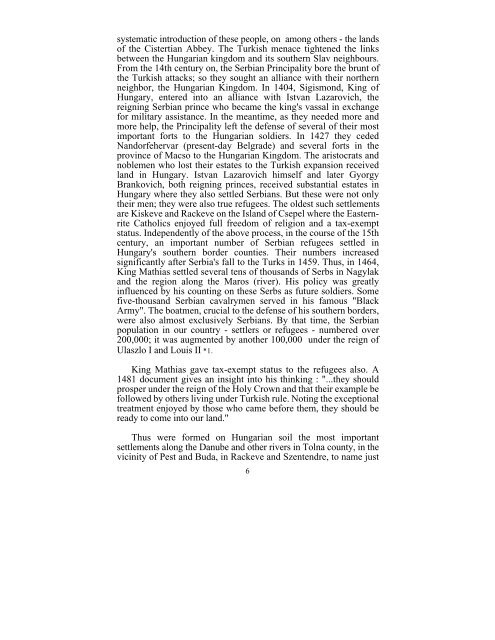the text - Corvinus Library - Hungarian History
the text - Corvinus Library - Hungarian History
the text - Corvinus Library - Hungarian History
Create successful ePaper yourself
Turn your PDF publications into a flip-book with our unique Google optimized e-Paper software.
systematic introduction of <strong>the</strong>se people, on among o<strong>the</strong>rs - <strong>the</strong> lands<br />
of <strong>the</strong> Cistertian Abbey. The Turkish menace tightened <strong>the</strong> links<br />
between <strong>the</strong> <strong>Hungarian</strong> kingdom and its sou<strong>the</strong>rn Slav neighbours.<br />
From <strong>the</strong> 14th century on, <strong>the</strong> Serbian Principality bore <strong>the</strong> brunt of<br />
<strong>the</strong> Turkish attacks; so <strong>the</strong>y sought an alliance with <strong>the</strong>ir nor<strong>the</strong>rn<br />
neighbor, <strong>the</strong> <strong>Hungarian</strong> Kingdom. In 1404, Sigismond, King of<br />
Hungary, entered into an alliance with Istvan Lazarovich, <strong>the</strong><br />
reigning Serbian prince who became <strong>the</strong> king's vassal in exchange<br />
for military assistance. In <strong>the</strong> meantime, as <strong>the</strong>y needed more and<br />
more help, <strong>the</strong> Principality left <strong>the</strong> defense of several of <strong>the</strong>ir most<br />
important forts to <strong>the</strong> <strong>Hungarian</strong> soldiers. In 1427 <strong>the</strong>y ceded<br />
Nandorfehervar (present-day Belgrade) and several forts in <strong>the</strong><br />
province of Macso to <strong>the</strong> <strong>Hungarian</strong> Kingdom. The aristocrats and<br />
noblemen who lost <strong>the</strong>ir estates to <strong>the</strong> Turkish expansion received<br />
land in Hungary. Istvan Lazarovich himself and later Gyorgy<br />
Brankovich, both reigning princes, received substantial estates in<br />
Hungary where <strong>the</strong>y also settled Serbians. But <strong>the</strong>se were not only<br />
<strong>the</strong>ir men; <strong>the</strong>y were also true refugees. The oldest such settlements<br />
are Kiskeve and Rackeve on <strong>the</strong> Island of Csepel where <strong>the</strong> Easternrite<br />
Catholics enjoyed full freedom of religion and a tax-exempt<br />
status. Independently of <strong>the</strong> above process, in <strong>the</strong> course of <strong>the</strong> 15th<br />
century, an important number of Serbian refugees settled in<br />
Hungary's sou<strong>the</strong>rn border counties. Their numbers increased<br />
significantly after Serbia's fall to <strong>the</strong> Turks in 1459. Thus, in 1464,<br />
King Mathias settled several tens of thousands of Serbs in Nagylak<br />
and <strong>the</strong> region along <strong>the</strong> Maros (river). His policy was greatly<br />
influenced by his counting on <strong>the</strong>se Serbs as future soldiers. Some<br />
five-thousand Serbian cavalrymen served in his famous "Black<br />
Army". The boatmen, crucial to <strong>the</strong> defense of his sou<strong>the</strong>rn borders,<br />
were also almost exclusively Serbians. By that time, <strong>the</strong> Serbian<br />
population in our country - settlers or refugees - numbered over<br />
200,000; it was augmented by ano<strong>the</strong>r 100,000 under <strong>the</strong> reign of<br />
Ulaszlo I and Louis II *1.<br />
King Mathias gave tax-exempt status to <strong>the</strong> refugees also. A<br />
1481 document gives an insight into his thinking : "...<strong>the</strong>y should<br />
prosper under <strong>the</strong> reign of <strong>the</strong> Holy Crown and that <strong>the</strong>ir example be<br />
followed by o<strong>the</strong>rs living under Turkish rule. Noting <strong>the</strong> exceptional<br />
treatment enjoyed by those who came before <strong>the</strong>m, <strong>the</strong>y should be<br />
ready to come into our land."<br />
Thus were formed on <strong>Hungarian</strong> soil <strong>the</strong> most important<br />
settlements along <strong>the</strong> Danube and o<strong>the</strong>r rivers in Tolna county, in <strong>the</strong><br />
vicinity of Pest and Buda, in Rackeve and Szentendre, to name just<br />
6
















